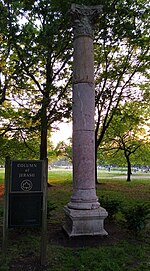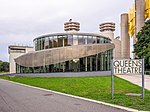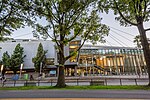IND World's Fair Line
The IND World's Fair Line, officially the World's Fair Railroad, was a temporary branch of the Independent Subway System (IND) serving the 1939 New York World's Fair in Queens, New York City. It split from the IND Queens Boulevard Line at an existing flying junction east of Forest Hills–71st Avenue station, ran through the Jamaica Yard and then ran northeast and north through Flushing Meadows–Corona Park, roughly along the current path of the Van Wyck Expressway. The line continued along a wooden trestle to the World's Fair Railroad Station, located slightly south of Horace Harding Boulevard (now the Long Island Expressway). The World's Fair station, the only one on the line, consisted of two tracks and three platforms. The line was planned beginning in 1936, and it was constructed in 1938. The line and station were only open in 1939 and 1940 during the Fair's operating season. Passengers had to pay a ten-cent fare to use this line, double the subway's standard five-cent fare. This was not the only line to serve the world's fair. The Interborough Rapid Transit and the Brooklyn Manhattan Transit operated service to the Fair via the World's Fair station of their joint-operated IRT Flushing Line. The World's Fair Railroad and station are the only IND line and station to have been closed and demolished. Remnants of the line are still present in the Jamaica Yard.
Excerpt from the Wikipedia article IND World's Fair Line (License: CC BY-SA 3.0, Authors).IND World's Fair Line
Van Wyck Expressway, New York Queens
Geographical coordinates (GPS) Address Nearby Places Show on map
Geographical coordinates (GPS)
| Latitude | Longitude |
|---|---|
| N 40.742753 ° | E -73.837762 ° |
Address
Van Wyck Expressway
Van Wyck Expressway
11355 New York, Queens
New York, United States
Open on Google Maps










